{english below} Andy Takakjian es un artista norteamericano de Los Angeles de California, perteneciente a esa generación contracultural y libre de los 70 y 80, artifice de aquellos gráficos clásicos de los años 80 de Vision Street Wear, autenticas piezas icónicas de la cultura pop y el skateboard de las ultimas décadas. Siempre hemos tenido curiosidad por la persona que había realizado esos diseños de Vision tan icónicos en los 80, y a la vez tan lejanos del estilo de otros maestros de la época como VC Johnson o Jim Phillips. El estilo de Andy en esas tablas bebia directamente de la imagen ochentera tan de moda en portadas de discos, videoclips, ropa, la música disco, electro, funk, el estilo pop, etc… Tras ver el gran documental Sk8Face por fin le ponemos cara al genio y le escuchamos contar su historia, parte de ella. Así que nos decidimos a escribirle para entrevistarlo y seguir conociéndolo un poquito más.
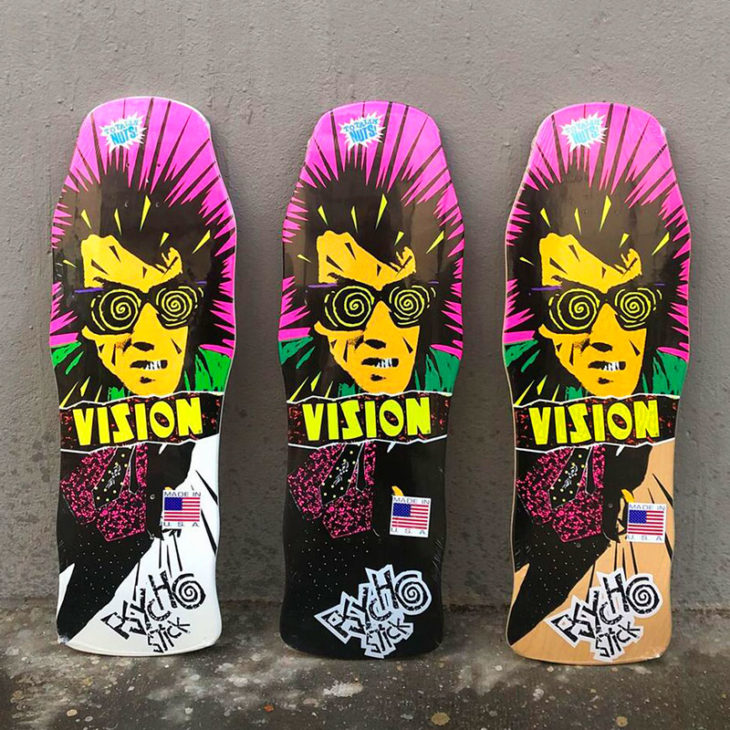
¿Quién es Andy Takakjian?
¿Quién? No tengo ni idea, nunca he oído hablar de él…
¿Cómo te iniciaste en el mundo del arte y los gráficos?
No lo sé, todo sucedió, hice lo que parecía ser natural, supongo, siempre seguí caminos artísticos desde muy temprano, trabajando en imprentas y tiendas de arte, luego llegó Ocean Pacific y supongo que tuvo un gran impacto que me dio la fuerza para perseverar, desde entonces… y aquí estamos…

¿Cuáles fueron sus influencias en el arte pop? ¿De la música, del grafiti, de la propia ciudad de California?
Tengo que decir que todas esas cosas han tenido una influencia en mí en varios momentos…, directa o indirectamente. A veces las utilizo abiertamente, a veces se convierten en un sublime trasfondo…, como los condimentos de un guiso. Ciertamente son factores que me guían, así como muchos otros que encuentro o he experimentado o absorbido a lo largo de mi vida. Obviamente el arte pop ha sido una gran influencia…, un aumento aditivo al arte comercial y en el mismo sentido es también un reflejo de ese medio…, la música marca un ritmo, un tema o un tempo, un estado de ánimo, añade color, estilo y tono.
El grafiti puede añadir textura y estilo… y la ciudad puede dar forma a todo el matiz y el aspecto humano a través del reflejo…, todo esto se mezcla en un gran batido de chocolate, cebolla y salchichas y se convierte en una especie de arte.
Oye, unas gafas de sol y unas chanclas en Abu Dhabi, ¡por qué no!

¿Y en el skateboarding?
Bueno, no sé si he tenido influencias específicas conscientes, pero la cultura playera del punk rock y el surf, el sur de California, la música, el arte, los gráficos, los envases, los medios de comunicación y las experiencias vitales han influido más o menos a nivel subconsciente. Casi cualquier cosa puede inspirarme, una puesta de sol, un envoltorio de caramelo, un tractor, un pan mohoso… nunca lo sé. Simplemente dejo que fluya y veo lo que pasa… Hago lo que me gusta y lo que me divierte y me esfuerzo por crear algo nunca visto… Como no hay reglas ni límites más allá de la forma de la tabla, todo es posible…, en cambio, otros deportes tienen elementos necesarios que determinan su naturaleza…, el skateboarding no necesita esos identificadores, es totalmente libre y abierto a la expresión personal. Vivir en un lugar dónde el skateboarding y todo tipo de deportes de acción son actividades de todo el año tiende a ser muy influyente, ¡perros con gafas de sol y camisas hawaiianas en anuncios de cerveza montando en monopatines es la vida cotidiana!. Dibujo lo que veo cada día, si viviera en Mongolia probablemente dibujaría yaks y yurtas.
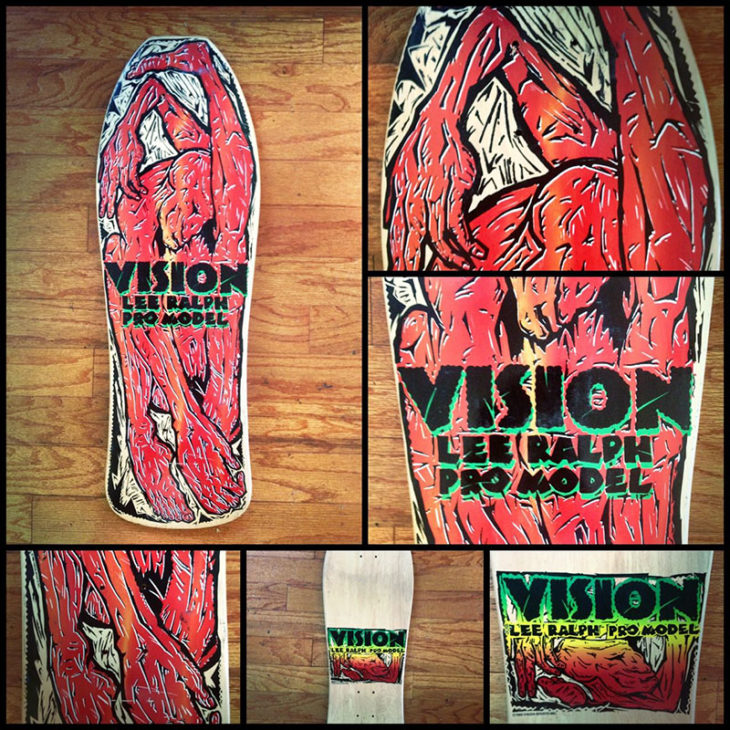
¿Cómo entras en Vision?
Utilicé la puerta… En realidad, un día me llamaron de Vision y me preguntaron si estaba interesado en diseñar un monopatín para ellos, así que fui y conocí a Brad Dorfman y Mark Gonzales en el departamento de arte…, y fue entonces cuando hicimos el primer gráfico de Marks…. luego unos meses después me llamaron para hacer el PsychoStick y me pidieron que subiera a bordo y me ofrecieron un escritorio…, así que traje mis bolígrafos y lápices y allí estaba…
¿Cómo era trabajar con los gráficos en esos años? ¿Todo a mano, ordenadores…?
En aquella época no teníamos ordenadores, estaban en el horizonte, así que sólo había papel, bolígrafos, tijeras, cinta adhesiva y pegamento; nos sentábamos con esos materiales y dibujábamos o construíamos…, teníamos una máquina Xerox que se convirtió en una herramienta importante. Hicimos todo tipo de cosas con esa máquina y realmente la llevamos a sus límites creando nuevos efectos y experimentos, como científicos locos inventando frankensteins, así que había una gran cantidad de mezcla de cosas mecánicas y dibujadas a mano juntos en ese momento, más o menos lo que hizo el trabajo y se veía bien … Es curioso que muchos de los efectos de desgaste que creamos en aquella época se sigan utilizando hoy en día en productos cotidianos…
¿quién lo iba a decir?
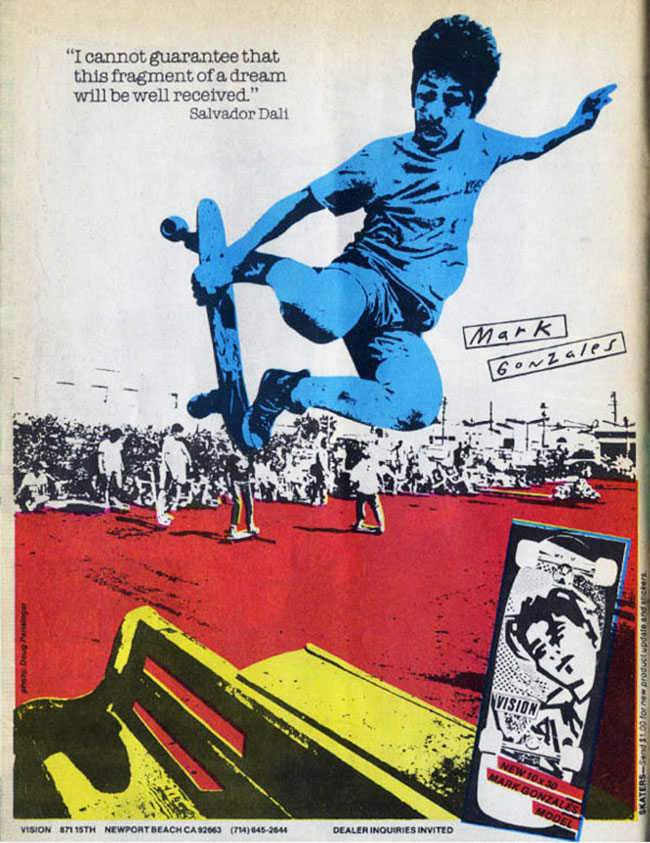
Cuéntanos la historia del diseño de Mark Gonz.
De alguna manera, un día recibí una llamada de alguien de Vision y me pidieron que fuera a ver si podía diseñar algo para un skater profesional para el que estaban haciendo un nuevo monopatín… así que fui, conocí a Brad Dorfman, me dio un rápido tour por el departamento de arte de una habitación y me presentó a Mark Gonzales: “Lo llamamos The Gonz…”. Me mostraron la nueva tabla de skate en blanco y me dijeron: ¿puedes hacer algo genial? Dije que lo intentaría…
Y me fui a casa…, pensando…, ¿qué es lo que quieren? no me dieron ninguna dirección o idea, como dibujarme un elefante o un plátano… No tenía ni idea de skateboard, ¿qué es el skateboard?, no sé de skateboard…, pero tengo que hacer algo… así que tiré algunos trastos fuera de mi escritorio, vamos a ver qué dicen… Volví una semana más tarde, entré y les mostré lo que tenía. Brad le preguntó a Mark lo que pensaba y recuerdo que su respuesta fue algo sublime y discreto como un gruñido y un encogimiento de hombros y “uh… bien” o algo así… Y eso fue todo, supongo que les gustó lo que hice.
El arte se puso en producción y se fue … Shazam, cohete a la luna, ¿quién lo iba a decir?.
Eso es todo, no hay gran pensamiento o intelectualización, sólo pura espontaneidad ciega, slam bam, gracias señora…
“No hay tiempo para discutir Indy, lánzame el ídolo, ¡te lanzo el látigo…!” ¿Quién lo diría?
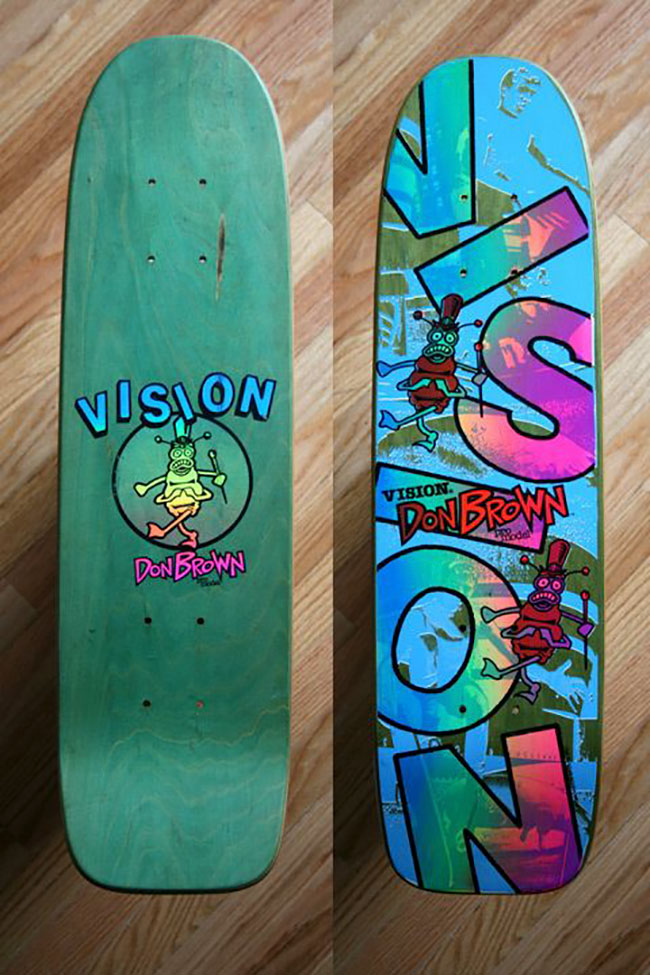
¿Y la historia detrás de Psychos? ¿Es cierto que era una persona real que trabajaba en Vision?
Unos meses después del tablero de Gonz recibí una segunda llamada de Vision para hacer otra baraja (el PsychoStick) y volví a ir una vez más. Brad me mostró la nueva forma en blanco …, esta vez Marty Jiménez y Greg Evans estaban allí y me dieron una pequeña idea de lo que estaban pensando, pero de nuevo … no mucho. Sólo algo un poco loco…
¿Qué piensas?, ¿puedes hacer algo genial?…, si supongo que si, déjame ver así que de nuevo me llevé la forma de la tabla a casa y traté de averiguar qué hacer con “locos y chiflados…”. Tenía esta foto de un amigo mío en mi escritorio y pensé que podría funcionar, así que añadí algunas cosas, lo pegué todo y volví a Vision y trabajé un poco más con la fotocopiadora y algunos rotuladores. La tipografía y eso fue todo, fue aprobada y enviada a producción…, de alguna manera, en el último minuto, cogí un rotulador y puse los remolinos en las gafas… más o menos como una broma y esperando totalmente que fuera rechazado, pero lo mantuvieron y así es como salió… ¡¡¡Totalmente loco!!!
Una vez más… slam bam, gracias Sam…, Sam y yo…, puro salvajismo idiota, ¿quién lo diría?. El hombre psicópata del PsychoStick era y es realmente una persona real, ¡al menos la última vez que lo comprobé!. Gregory era un amigo mío y la foto fue tomada por otro amigo algún tiempo antes de Vision. Y sí, trabajaba en Vision, pero no recuerdo cuándo empezó, pero sé que fue justo en la época del PsychoStick…, es gracioso después de un tiempo los chicos locales alrededor de Visión comenzaron a reconocerlo …, al principio era halagador, pero después de un tiempo la diversión comenzó a desaparecer y Gregory tuvo que empezar a entrar y salir a escondidas del edificio y usar disfraces para evitar a todos los niños que lo acosaban por autógrafos y pegatinas, realmente se hizo un poco ridículo. Creo que en un momento dado nos planteamos que un doble de Psycohman hiciera de señuelo para atraer a los niños y que Gregory pudiera llegar al trabajo a tiempo… Túneles secretos, lanzamientos de cápsulas de helicópteros, trajes invisibles…
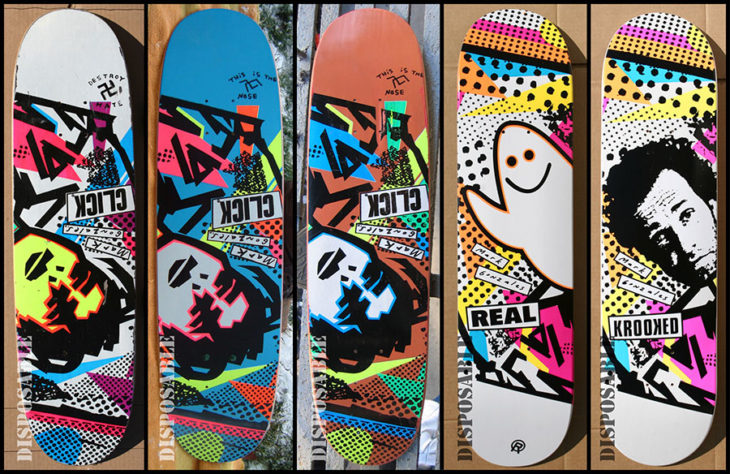
¿¡Tienes una colección de más de 10.000 coches en miniatura!?
Algo así, ¡hay bastantes! He perdido la cuenta, es más, una acumulación que una colección, más bien me han coleccionado a lo largo de toda una vida…, y no necesariamente una decisión, más de un pasatiempo continuo/pasatiempo. Siempre hay algo nuevo lleno de intriga, disfrute, conocimiento e inspiración.
Los utilizo en mi trabajo de vez en cuando y los encuentro fascinantes. Algunas personas coleccionan sellos, mariposas, muñecas de porcelana o monopatines, para mí son los pequeños coches de juguete de fundición, ¡las contribuciones son siempre bienvenidas!.
¿Para qué otras marcas de skate has hecho gráficos o ropa, música, surf…?
Antes de Vision estuve en Ocean Pacific, mientras estaba en Vision hice algunos diseños para Simms y SchmittStix ya que estaban bajo el paraguas de Vision, todo el mundo estaba en el mismo edificio de todos modos y era sólo parte del trabajo diario que hicimos. Y por supuesto entre Op y Vision hice trabajos independientes para California Lifestyles, Gordon & Smith, QuikSilver, Gotcha, Catchit, Cylinders y algunos otros que no puedo recordar, tantos y tantos, hace tanto tiempo.
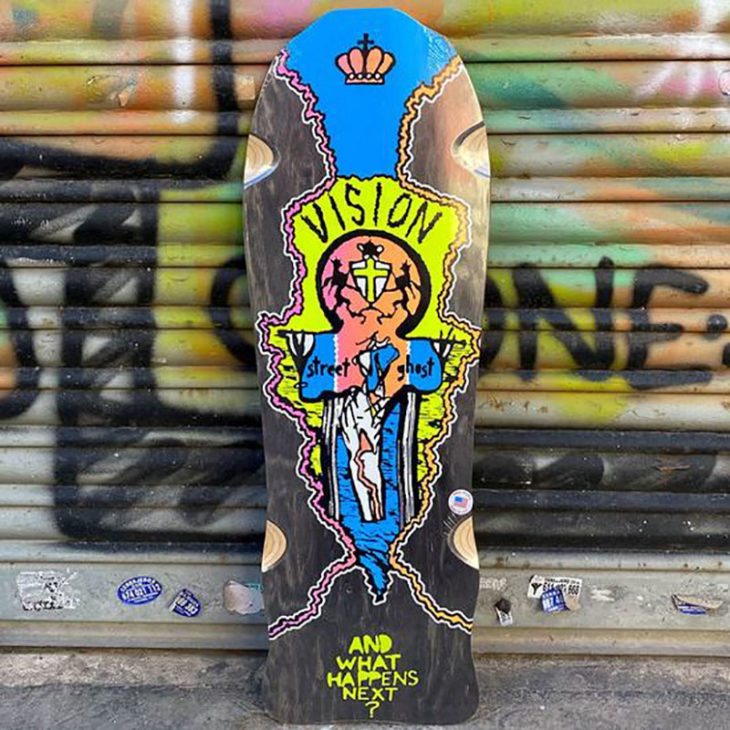
¿Eres originario de Los Ángeles? ¿Cómo es tu visión de esa ciudad y el impacto que la cultura pop, el skate, el punk… ha tenido en la ciudad?
Sí, soy originario de Los Ángeles, el sur de California, tierra de intrigas y efectos especiales…. Los Ángeles genera mucha cultura pop por sí misma, es la principal industria aquí, generando fantasías, ilusiones y recortes de cartón de ídolos adolescentes más grandes que la vida, camiones Chevy, la industria del entretenimiento utiliza grandes talentos de todo el mundo y explota lo que hay a su alrededor para crear tendencias de moda y modelos de consumo a nivel mundial… La cultura pop en sí misma incluye el skateboarding y el punk y la exposición mediática perpetúa su impacto. El skateboarding y el surf van de la mano de forma natural aquí, el clima y el paisaje se adaptan bien a ello y, por tanto, forman parte del estilo de vida y la cultura naturales. El estilo punk es más bien un reflejo natural de la vida en una gran ciudad y creo que ha añadido otra capa de textura libre y pensamiento libre hacia el exterior a la evolución de la ciudad. Ambas cosas han derribado las barreras de aceptación a lo largo de los años y creo que han permitido que la ciudad crezca en muchas direcciones, tanto de forma abstracta como concreta.
Es un gran lugar para vivir y he disfrutado viéndola crecer, expandirse y cambiar… Gente de todo el mundo vive aquí y ha traído sus muchas y variadas culturas con ellos y ha establecido comunidades sólidas… Ya no siento la necesidad de viajar mucho… las montañas, el desierto, el océano…, todo está aquí… en mi propio patio trasero… ¡y disfruto de todo ello!

¿Cuándo terminó Visión y por qué? ¿Qué hiciste después de trabajar en Visión?
Para mí, Vision terminó a finales de 1989, sobre todo porque era el momento…, el momento de crecer y ver qué más había más allá de la industria de los deportes de acción; era el momento de buscar nuevas habilidades y de ir con valentía donde ningún artista tonto había ido antes… Era el momento de seguir adelante, después de Vision hice un montón de cosas diferentes, factotum, cualquier cosa que se me ocurriera como portadas de libros, flyers para cafeterías, tarjetas de visita, diseño de envases, carteles de películas, portadas de discos, un poco de producción de televisión, películas y trabajos de teatro, restauración de coches y motos, fotos de bandas. trabajo de neón, logos de empresas, diseños de camisetas, vidrieras, espectáculos…, todo tipo de cosas…, lo que se me ocurriera pagará las facturas y me interesará. Ha sido un carrusel caleidoscópico, muy variado, divertido, desafiante e instructivo… Si tuviera que volver a hacerlo, lo haría todo de nuevo… pero quizá con un poco menos de arrogancia.
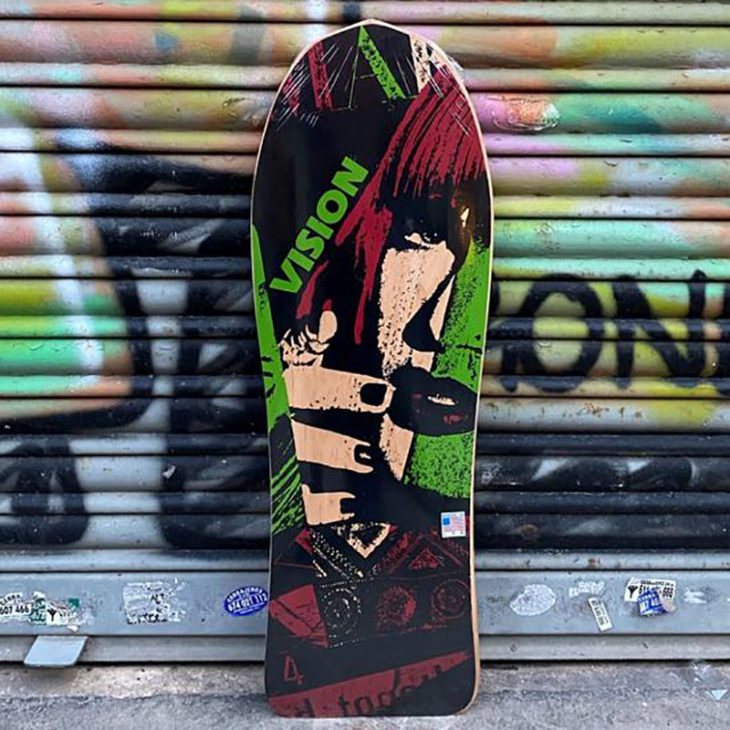
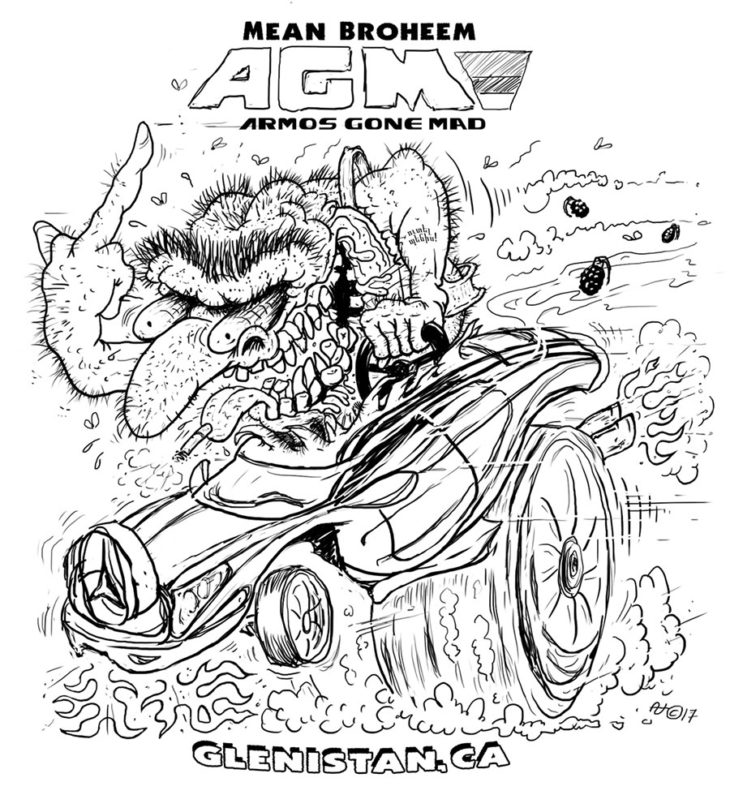
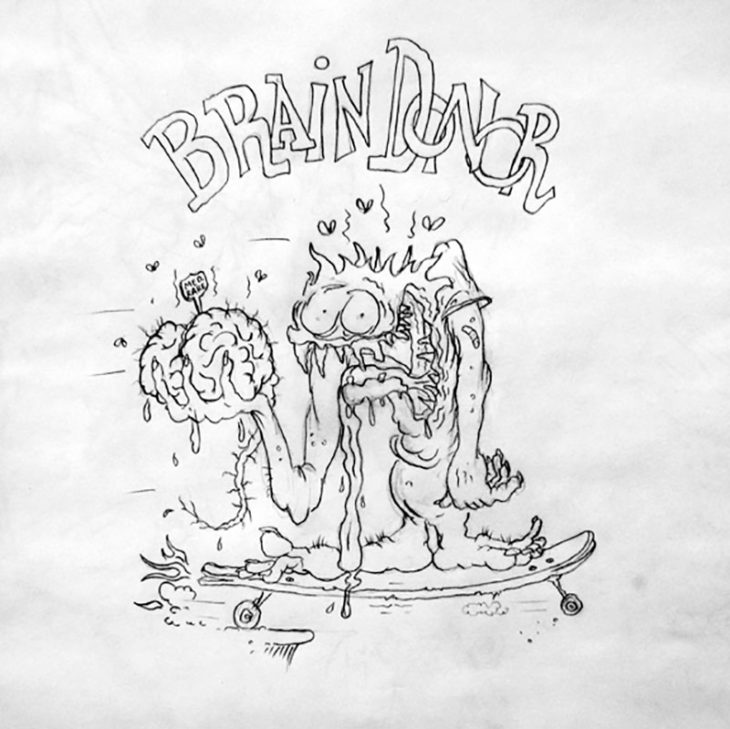
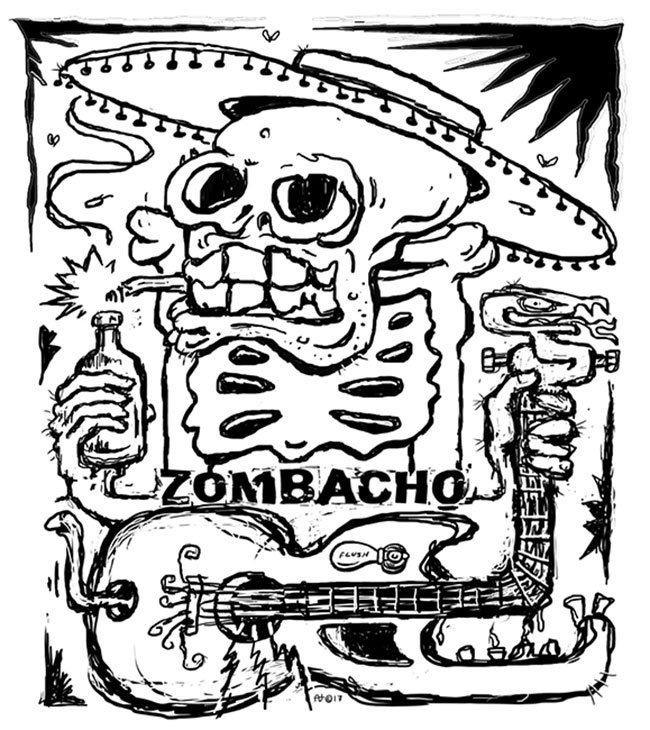


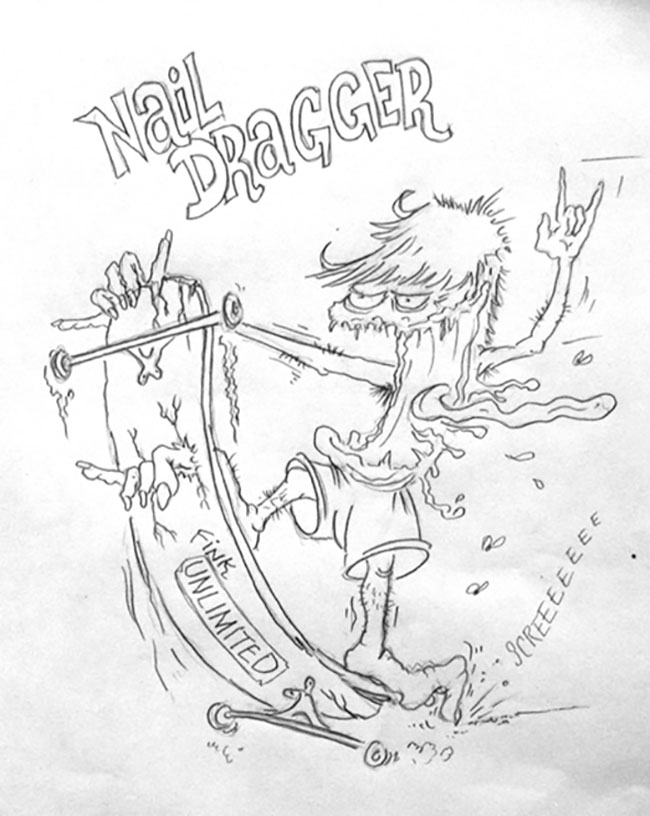
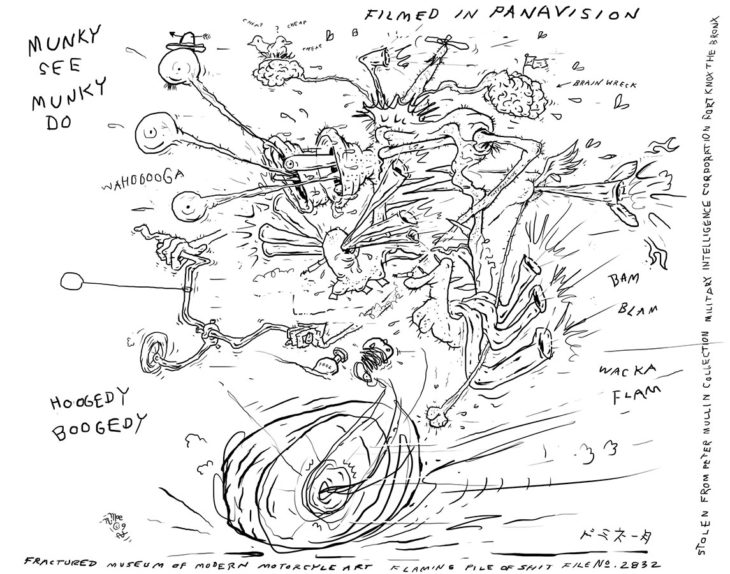
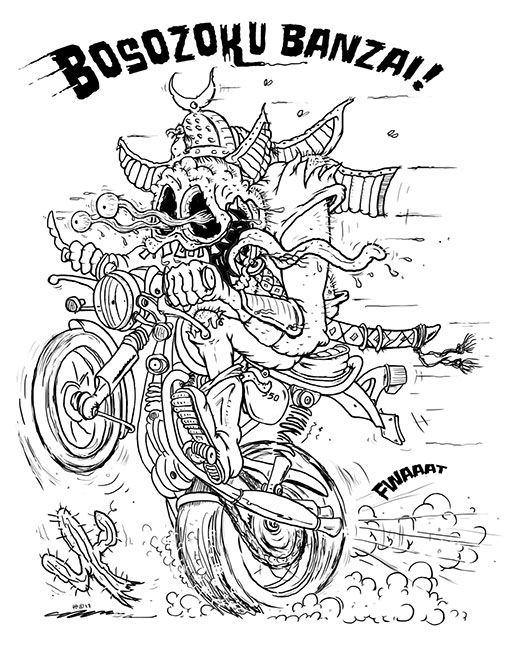

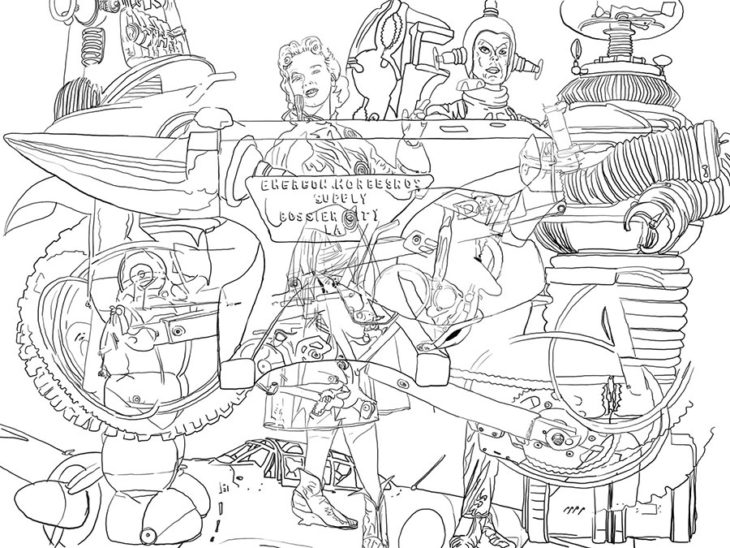
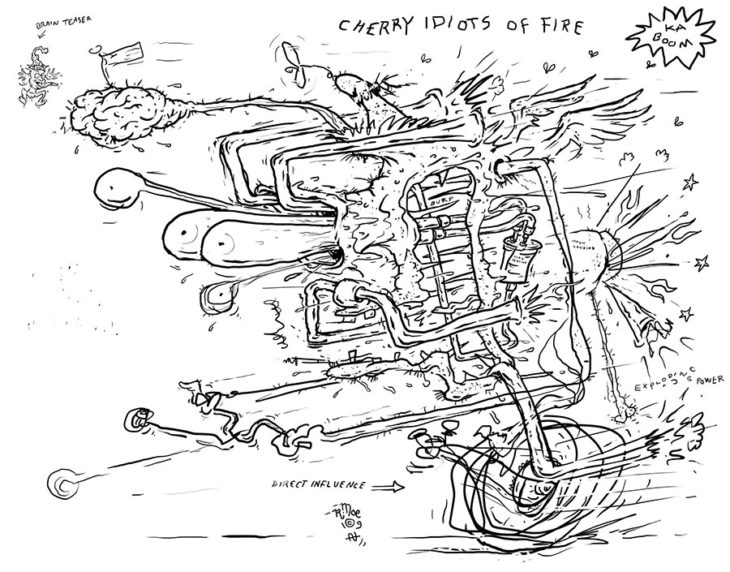
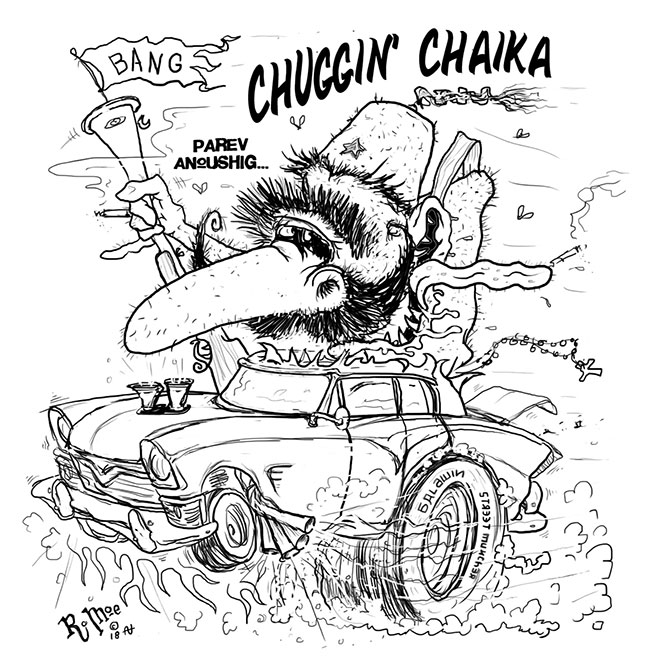

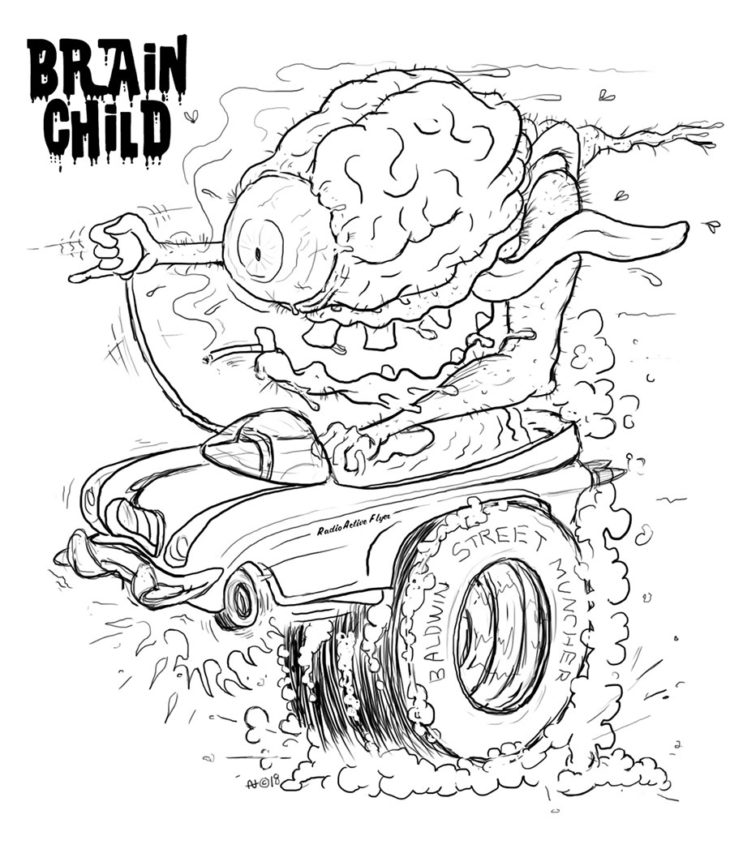
English:
ANDY TAKAKJIAN
Andy Takakjian is an American artist from Los Angeles, California, belonging to that countercultural and free generation of the 70s and 80s, he is the creator of those classic graphics from the 80s of Vision Street Wear, authentic iconic pieces of pop culture and skateboarding of the last decades . We have always been curious about the person who made those Vision designs so iconic in the 80s, and at the same time so far from the style of other masters of the time such as VC Johnson or Jim Phillips. Andy’s style in those tables drank directly from the eighties image so fashionable on album covers, video clips, clothes, disco music, electro, funk, pop style, etc … After seeing the great documentary Sk8Face he finally we put a face on the genius and we listen to him tell his story, part of it. So we decided to write to interview him and keep getting to know him a little more.
Who is Andy Takakjian?
Who? I have no idea – never heard of him…
How did you get into the world of art and graphics?
I don’t know – it all just sort of happened, I just did what seemed to come naturally, I guess, always pursued artistic pathways very early on working in print shops and art supply stores, then Ocean Pacific came along and I guess that really had a great impact that gave me the moxie to persevere, it just went on from there… and here we are…
What were your influences on pop art? From music, graffiti, from the city of California itself?
I have to say all those things have had an influence on me at various times… directly or indirectly
sometimes I use them overtly sometimes they become a sublime undercurrent…, like seasonings in a stew certainly they are guiding factors as well as many others I encounter or have experienced or absorbed over a lifetime. Obviously pop art has been quite an influence…, an additive augmentation to commercial art and in the same sense, it´s also a reflection of that medium…, music sets a pace or theme or tempo, a mood, adds colour style and tone.
Graffiti can add texture & style… and the city can shape the whole overtone & human aspect through reflection…, all this mixes up into a big chocolate fudge onion martini olive sausage smoothie & turns into some kind of art.
Hey, ray-bans and flip flops in Abu Dhabi dude, why not!
What were your influences on skateboarding?
Well, I don’t know if I had any conscious specific influences, but punk rock surfing beach culture, southern California, music, art, graphics, packaging, media and life experiences have all been influential more or less on a subconscious level. Almost anything could inspire me, a sunset a candy wrapper a tractor moldy bread, I never know.
I just let it flow & see what happens… I do what I like & what amuses me & strive to create something I´ve never seen before… Since there are no rules or confines other than the shape of a deck, anything is possible…, in contrast, other sports have requisite elements that determine that sports nature…, skateboarding doesn’t need those identifiers, it´s totally free and open to personal expression. So living in a place where skateboarding and all kinds of other action sports are year around activities tends to be very influential, dogs with sunglasses and hawaiian shirts in beer commercials riding skateboards is everyday life!
I draw what I see every day, if I lived Mongolia I´d probably draw yaks & yurts.
How did you get into vision skateboards?
I used the door… Actually, I got a call one day out of the blue from Vision and they asked if I was interested in designing a skateboard for them, so I went over and met Brad Dorfman and Mark Gonzales in the art department… and that´s when we did Marks first deck…, then a few months later they called me back to do the PsychoStick and they asked me to come aboard & offered me a desk… so I brought my pens and pencils and there I was…
How do you work on design in those years? How did you create the graphics? Everything at hand, computers …?
In those days we didn’t have computers, they were on the horizon, so it was paper, pens, scissors, tape and glue; we sat down with those materials or just drew or constructed…, we did have a xerox machine which became a major tool. We did all kinds of stuff with that machine and we really pushed it to its limits creating new effects & experiments, like mad scientists inventing frankensteins, so there was a great deal of mixing mechanical & hand drawn stuff together at that time- pretty much whatever got the job done & looked cool… Funny how a lot of those trashy gritty beaten down weathered effects we created back then I still see being used today in every day products…
Who knew?
Tell us the story behind the design of mark gonz?
Somehow, I got a phone call one day from someone at Vision and they asked me to come over to see if I could design something for a pro skater they were making a new skateboard for…,so I went over, met Brad Dorfman, he gave me a quick tour of the one room art department and introduced me to Mark Gonzales “We call him The Gonz…”
They showed me the new blank skateboard deck and said, can you do something cool…?
I said I´d give it a try…
And went home, … thinking…, what do they want? they didn’t give me any direction or idea, like draw me an elephant or a banana… I had no idea from skateboard, what is skateboard; I don’t know from skateboard… but I gotta do something… so I threw some junk together off my desk, let´s see what they say and go from there… I went back a week later, walked in showed them what I had. Brad asked Mark what he thought and I kind of remember his reply was something kind of sublime and understated like a grunt and a shrug and “uh.. okay” or something… And that was that, I guess they liked what I did?, the art got laid on the production desk and off it went… shazam, rocket to the moon, who knew?, That´s pretty much it, no great thought or intellectualization, just pure blind gut spontaneity ,slam bam, thank you ma’am…
“No time to argue Indy, throw me the idol , ) throw you thee whip…!”
Who knew?
And the story behind Psychos? Is it true that it was a real person who worked at Vision?
A few months after the Gonz board I got a second call from Vision to do another deck (the PsychoStick) and went back over once again Brad showed me the new blank shape… this time Marty Jiminez & Greg Evans were there and they gave me a little idea of what they were thinking of, but again…
Not much. Just something kinda crazy – zany – kinda nuts…
What do you think?, Can you do something cool?…yeah I guess so lemme see so again I took the board shape home and tried to figure out what to do with “crazy zany & nuts…” I just happened to have this photo of a buddy of mine on my desk and thought, gee that might kinda work, so I added a few things taped it all together and went back to Vision and did a little more work to it using the xerox machine, some markers slapped together. The typography and that was that and it got approved and sent downstairs for production… somehow at the last minute I grabbed a marker and put the swirls in the glasses…, pretty much as a gag and fully expecting that to be rejected, but they kept that & that´s how it went out…
Totally nuts!!!
Once again… slam bam thank you Sam…, Sam and I…, pure idiot savantry, who knew? The psycho-man guy on the PsychoStick really was and is a real person, at least the last time I checked!. Gregory was a pal of mine and the photo was taken by another pal some time before Vision. And yes, he did work at Vision, but I can´t remember when he started, but I know it was right around the time of the PsychoStick…, it´s funny after a while the local kids around Vision started to recognize him…
flattering at first but after a while the amusement started to wear off and Gregory had to start sneaking in and out of the building wear disguises to avoid all the kids hounding him for autographs and stickers, it really got kind of ridiculous. I think at one point we considered having a Psycohman look-alike work as a decoy to lure the kids away so Gregory could get to work on time…Secret tunnels helicopter capsule drops, invisible suits were also considered.
Do you have a collection of more than 10,000 miniature cars? Why did you decide to collect so many cars?
Something like that, there is quite a few! I´ve lost count. It´s really more of an accumulation than a collection more like they collected me over a lifetime. And not necessarily a decision, more of a continual hobby/pastime. Always something new filled with intrigue enjoyment knowledge and inspiration. I use them in my work from time to time, I find them fascinating. Some people collect stamps or butterflies or porcelain dolls or skateboards, for me its little diecast toy cars contributions are always welcome!
For what other skate brands have you made graphics or clothing, music, surfing …?
Prior to Vision I was at Ocean Pacific, while I was at Vision i did some designs for Simms and SchmittStix as they were under the Vision umbrella, everybody was in the same building anyway and it was just part of the daily work we did. Of course. in-between Op and Vision I did freelance work for California Lifestyles, Gordon and Smith, QuickSilver, Gotcha, Catchit, Cylinders and a few others I can´t remember, so much so many, so long ago
Are you originally from Los Angeles? How is your vision of that city and the impact that pop culture, skateboarding, punk… has had on the city?
Yes, I´m originally from Los Angeles, southern California, land of enchantment intrigue and special effects…. well – Los Angeles itself generates a lot of pop culture on its own, it´s the main industry here, generating fantasies, illusions and cardboard cutouts of larger than life, whatnots teen idols, chevy trucks,
the entertainment industry utilizes great talent from all over the world and exploits what is around it to create fashions trends and role models for consumption on a global basis… Pop culture in itself includes skateboarding and punk and media exposure perpetuates their impact. Skateboarding and surfing go hand in hand naturally here, the climate and landscape are well suited to it ,so it´s part of the natural lifestyle & culture punk style is more of a natural reflection of living in a big city and I think it has added another layer of free texture and outward free thinking to how the city has evolved both have broken down hard fast barriers of acceptance over the years and I think they have allowed the city to grow in many directions – abstractly as concretely.
It´s a great place to live and I´ve enjoyed watching it grow, expand and change… People from all over the world live here and brought their many and varied cultures with them and established solid communities… I don’t feel the need to travel much anymore …, the mountains, the desert, the ocean…, it´s all right here… in my own back yard… and I enjoy every bit of it…!
When did vision end and why? What did you do after working on vision?
For me Vision ended in late 1989, primarily because it was time…, time to stretch and grow and see what else was out there beyond the action sports industry; it was time to seek out new skills and boldly go where no dumb artist has gone before… It was time to move along after Vision I did a lot of different things, factotum, whatever came along, how book covers, cafe flyers, business cards, packaging, design movie posters, album covers, a little television production, film, movie, work theater, sets car and motorcycle restoration, band photos, neon sign work, company logos, tee shirt, designs stained glass art, shows…, all kinds of stuff…, whatever came along, paid the bills and interested me it´s been a many and varied kalaidoscopic carousel, fun, challenging and enlightening…
If had it all to do over again, I´d do it all again… but maybe with a little less hubris.